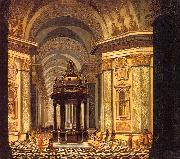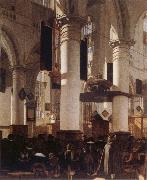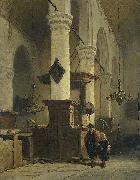Wholesale Oil Painting Reproductions No Minimum and Door to Door! |
|||||||||||
|
|
|||||||||||

|
|||||||||||
|
|
|
||||||||
All Wilhelm Schubert van Ehrenberg Oil Paintings |
||||||||
|
|
||||||||
|
|
||||||||
|
Artist Introduction: 1630-1676
Flemish
Wilhelm Schubert van Ehrenberg Location |
||||||||
|
|
||||||||
|
Church Interior Painting ID:: 1105 |
1665
The Hermitage, St.Petersburg |
|||||||
Height Width |
INS/CM Quality |
|||||||
|
X |
| |||||||
|
|
||||||||
All Emmanuel de Witte Oil Paintings |
||||||||
|
|
||||||||
|
|
||||||||
|
Artist Introduction: Dutch
1617-1692
Emmanuel de Witte Gallery
Dutch painter. He was one of the last and, with Pieter Saenredam, one of the most accomplished 17th-century artists who specialized in representing church interiors. He trained with Evert van Aelst (1602-57) in Delft and in 1636 joined the Guild of St Luke at Alkmaar, but he was recorded in Rotterdam in the summers of 1639 and 1640. In October 1641 his daughter was baptized in Delft, where he entered the Guild of St Luke in June 1642 and lived for a decade, moving to Amsterdam c. 1652. He began his long career as an unpromising figure painter, as can be seen in the Vertumnus and Pomona (1644) and two small pendant portraits (1648; all Rotterdam, Mus. Boymans-van Beuningen). |
||||||||
|
|
||||||||
|
|
Church Interior Painting ID:: 33717 |
mk86
c.1660
Oil on canva
80x66cm
St Petersburg,Hermitage
|
||||||
Height Width |
INS/CM Quality |
|||||||
|
X |
| |||||||
|
|
||||||||
All Johannes Bosboom Oil Paintings |
||||||||
|
|
||||||||
|
|
||||||||
|
Artist Introduction: (born The Hague, February 18, 1817 - died there September 14, 1891) was a Dutch painter and watercolorist of the Hague School, known especially for his paintings of church interiors.
At the age of 14 he became a student of Bartholomeus van Hove and painted in his studio along with Van Hove's son Hubertus van Hove. Together they worked on the pieces of scenery that Van Hove created for the Royal Theatre in The Hague. In addition, Bosboom took lessons from 1831 to 1835 and again from 1839 to 1840 in the Hague Academy of Art. Here he also made the acquaintance of Antonie Waldorp and Wijnand Nuyen.
The young Bosboom traveled to Germany in 1835 to Dusseldorf, Cologne and Koblenz and painted the watercolor View of the Mosel Bridge at Koblenz. This painting was purchased by Andreas Schelfhout, who became his confidante and friend. In 1939 he traveled to Paris and Rouen and received a silver medal for View of the Paris Quay and the Cathedral at Rouen. He also painted a number of church interiors, a relatively traditional genre in which the seventeenth century artists Pieter Saenredam and Emanuel de Witte served as important examples. Bosboom had a great deal of success with these pieces, and for the rest of his career he would repeatedly return to this theme, which was the one in which he would achieve his greatest fame.
Bosboom's choice of subject matter may seem to isolate him from the rest of the Hague School, but his search for ways to reproduce the spatial atmosphere through light, shadow, and nuances of color places him in the very mainstream of this group. In 1873, during a stay in Scheveningen, he painted many watercolors of town views, the dunes, the beach and the sea. It is possible that these watercolors encouraged Hendrik Willem Mesdag and Jacob Maris to concentrate further on the sea and beach as subjects.
|
||||||||
|
|
||||||||
|
|
Church Interior Painting ID:: 93329 |
1850 - 1891
Medium oil on panel
Dimensions 18.5 x 14.5 cm (7.3 x 5.7 in)
cjr |
||||||
Height Width |
INS/CM Quality |
|||||||
|
X |
| |||||||
|
|
||||||||
|
Prev Next
|
||||||||
|
|
||||||||
|
Related Paintings to Johannes Bosboom :. |
||||||||
|
|
||||||||
|
CONTACT US |



